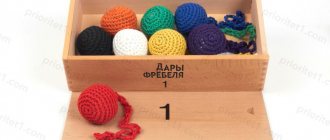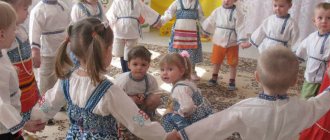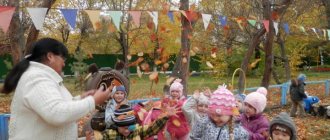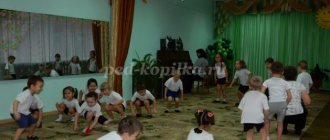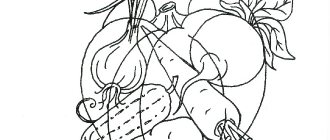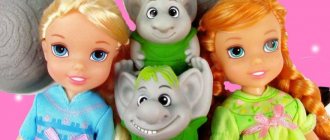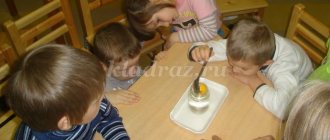Even the youngest children are happy to participate in the process of playful self-massage, often showing creativity, offering new movements, options for performing exercises, and at the same time receiving basic ideas about their own health, acupuncture, and the ability to improve their health with just the touch of their hands. Children's self-massage, with its simplicity and accessibility, the ability to organically include it in various types of activities, through the free expression of emotions, helps to strengthen the physical and mental health of children.
Self-massage for preschoolers is accompanied by funny poems designed to play up the massage movements, bright images that arouse the interest of children, allowing them to relax without thinking about the therapeutic effect of the exercises.
see also
Children's physical exercises - health-saving technologies Prevention of flat feet - health-saving technologies Relaxation during physical education classes - health-saving technologies
Using children's self-massage in physical education classes
When choosing health-saving technologies for working with children, based on medical indications, age characteristics and diagnostics of the physical development of children, I came to the conclusion that play self-massage is quite appropriate in the water and final part of physical education classes, as well as between performing certain basic movements to relieve tension. Self-massage allows you to enhance the effect of practicing positive emotions, arouse interest in taking care of personal health, and form the habit of a healthy lifestyle. It is important to teach children to perform massaging movements gently, effortlessly, lightly stroking, or lightly pressing on parts of the body, in the direction from the periphery to the center.
Massage techniques
- pressing
- stroking
- tapping
- kneading
- trituration
- topping
Expected results of massage
Educational direction
- mastering the rules of self-massage
- mastery of the simplest self-massage techniques
Wellness direction
- improved blood circulation
- improvement of metabolic processes
- strengthening the arch of the foot
- positive effect on the central nervous system
Educational direction
- encouragement of activity
- development of creative abilities
- development of positive emotions
The simplest types of self-massage
Foot massage
- clenching and unclenching of toes
- walking on massage mats
- walking along ribbed paths
- walking on toes, on heels
Massage of fingers and palms
- stretching each finger with light pressure
- lightly rubbing each finger without twisting (as if putting on a ring)
- various finger gymnastics
- rubbing the palms
- clapping hands
Hand massage
- stroking the arms from the hands to the shoulders
- tapping hands from hands to shoulders
- rubbing the forearms
Foot massage
- stroking from foot to thigh
- patting from foot to thigh
Back massage
- using a gymnastic stick
- using friendly help
Body massage
- side pinching
- stroking the abdomen with light circular movements clockwise
- stroking the center line of the chest with movements from bottom to top
Head massage
- stroking the head with hands from top to bottom
! Facial massage during physical education classes is unacceptable, as children’s hands may not be clean.
Bear massage, agricultural
A bear was walking. A big bear (we stomp on the back with our palms) A bear walked... (we stomp on a smaller area, with our fist, for example) A small bear cub walked (we walk along our back with our fingers) They found a large field (we rub our back with our palms). The bear said: “My-e-e field” (we speak in a deep voice, run in circles with our palms on the back) The bear said: “My-e-e field” (in a higher voice and smaller steps) The bear cub shouted “Mine” (in a thin voice, in small jumps ) They thought and decided that the field would be common. There's enough for everyone. And they decided to plant wheat. We plowed the field (we make some digging movements from the bottom up along the back, then down), leveled it (rubbed it with our palms) and planted the grains (knock lightly with the ends of our fingers all over the back). The rain poured on the grains (we move the back of our fingers in waves along the back), the sun warmed us, and the wheat has sprouted... Large and beautiful ears have grown... The time has come and they began to reap the wheat (with our left hand we take a fold of skin, as if pinching, we cut it with the right edge of our palm) They collected all the wheat into sheaves, there were a lot of sheaves (with the bottom of our fist we put tight marks on the back) Hooray! Hooray! Hurray! (in different voices) Oh, how much wheat we have grown, what a harvest! The bears rejoiced. We collected all the sheaves on a cart and took them to the mill. The horse took the wheat to the mill (we gallop along the back with four hooves) What was left was a clean, clean field (we stroke the back with our palms in a circular motion) And the bears ground the wheat grains - it turned out to be flour. They brought the flour home and baked a delicious one -delicious bread...
Self-massage during physical education classes
Massage of hands, fingers
Goal: to teach children to independently warm their hands during the cold season, relieve tension in their hands and fingers, help improve blood circulation, and develop fine motor skills. Self-massage “Making Fire” Everyone will need a polished wooden stick, for young and middle-aged children the sticks are in plain sight, for older children the sticks are hidden, you first need to find them; We vigorously twist the stick between our palms so that it becomes hot. Take the stick in the palm of your hand. We will make fire, twist the stick vigorously - and we will make fire for ourselves. Self-massage “We will warm our hands” The younger and middle age simply rub their palms to make it hot, the older age begin to rub their palms from the little fingers, gradually including all fingers, then rub their palms to make it hot, then spread their palms, trying to feel the “warm” between them ball" Oh-oh-oh, oh-oh-oh! How cold it is in the winter, So that we don’t get sick We need to rub our hands Self-massage “Kolobok” Young and middle-aged children imitate movements in a plane, older children start in a plane, end with their fingertips, as if a bun is between the palms, changing the direction of movement several times We put the dough in our hands Let's take it and start rolling it. The result is Kolobok Kolobok - ruddy side
Self-massage “We are having a lot of fun” Performed at the end of a physical education lesson; hands raised up Let's clench our fists tightly, And then we'll unclench them Let's unclench and squeeze them We're living a very fun life! Self-massage “Our hands will rest” It is carried out after exercises in throwing, climbing on a gymnastic wall; supporting one hand in the wrist with the other, shake it slightly Oh, our hands are tired. We’ll take the handle with the handle so that the hands can rest. Let’s shake the handle with the handle. Self-massage “Where are the hands” It is carried out after exercises in crawling, climbing; stretch your arms forward, raise them up and freely “throw” them down. These are your hands. All your palms are in sight. Now drop your hands. I’ll go look for them now.
Head massage
Goal: to teach children to relieve tension, restore attention, help improve blood circulation Self-massage “Hedgehog” After active play, younger and middle-aged children perform stroking movements with both hands from the forehead to the back of the head, then move their fingers on the sides from the base of the skull to the top of the head; The elders, lightly pressing on the skin with the fingers of their right and left hands, stroke the temples, moving first to the forehead, then to the back of the head, after which with their middle fingers they do acupressure at the base of the skull. A Hedgehog sat on a stump. The hedgehog’s legs are not visible. And you can’t tell at all. Is it a brush or a hedgehog?
Back massage
Goal: relax the back muscles, improve blood circulation, help friends Self-massage “Happy Rain” Children stand in a circle one after another, so that it is convenient to perform manipulations on the back of the person in front. First they clap their palms, then they tap their fingers, they pound their fists, at the end they stroke The rain went out for a walk Drip, drip, drip, He ran down the alley Drip, drip, drip, Children sit at home Drip, drip, drip, And don’t go out for a walk Drip, drip, cap When I leave, then come out here, everyone. Self-massage “Two cheerful geese” After the active game “Find yourself a mate”, two children massage each other’s backs in turns, the massage is performed simultaneously with both hands, children of the junior and middle groups simply poke their fingers, children of the senior and preparatory groups perform pinching, which allows In addition to fine motor skills, the “massage therapist” must develop coordination of movements. Two cheerful geese went out onto the meadow, nibble the grass, shouted merrily Ha-ha-ha, ha-ha-ha With the last words, the children change places Self-massage “Turtle” Performed in pairs, first lightly patting the back with palms from top to bottom, then vigorously pinching from the lower back upwards on the back
A turtle went for a swim and bit everyone out of fear: bite-bite-bite, bite I’m not afraid of anyone. With these words, quickly turn around and scare your partner “Uh!” and slow vibrating movements with the hands. Act scared Switch places
Self-massage “About little frogs” It is performed in a formation in a circle, first patting the palms on the back up and down, then pinching the arms from the elbow joints to the shoulders, then lightly tapping the fists on the back, at the end they freeze, depicting a roof over the head. Rain, rain More, more, there will be a holiday for the frogs, Thunder struck Bom-bom! All the frogs quickly enter the house.
Foot massage
Goal: prevent flat feet, strengthen the arch of the foot, improve blood circulation, develop fine motor skills of the fingers. Self-massage “Little Goat”
First, young and middle-aged children jump in place, older children step without lifting their socks off the floor in place, then the younger ones sit on the floor and stroke their legs with their palms from the feet upward, the older ones perform rubbing from a standing position, then alternately stretch one or the other the other leg and rotate the feet to the sides, the younger ones using the hands. At the end they perform jumps on the spot.
The goat jumped quickly and accidentally fell. The little goat sprained his leg. He sat down and cried on the path. I’ll tell you all, it’s not interesting without a game. The goat needs to play and jump with the kids.
Complex self-massage
Goal: to enhance the effect of practicing positive emotions, to arouse interest in taking care of personal health, to increase blood circulation, to improve metabolism Self-massage “Cockerel” Children line up in a circle, perform the suggested stroking movements, at younger and middle ages they repeat after the physical education instructor, at older ages - on one's own.
We made a cockerel. It is not painted yet. Let's take bright paints and start painting. We'll paint the crest with gold. We'll paint the wings and belly with yellow. We'll paint the back with red. Standing in front of each other. Now it's time for the legs. Let's paint the legs boldly. And now we need to paint the tail with seven stripes. Everyone tried, they weren't lazy. This is what the kids got: Golden combs.
Foot massage
The bear walked and walked (we plow our knuckles along the entire length of the foot) He came to the forest. (put a point with your fist) He took a saw and sawed, sawed, sawed (the entire surface of the foot was rubbed with the edge of his palm) He took an ax and chopped, chopped, chopped (again, the chopping movements were imitated with the edge of his palm) He took a hammer and hammered in nails (the fist imitated the movements of hammering nails) I straightened the leaves (massaging my fingers, each separately) I took a brush and painted it (affectionate stroking) Oh, what a great fellow! A wonderful craftsman! (kiss on the heel, the child is delighted, although, apparently, a little ticklish) *** Wall-wall (cheeks tickle) Ceiling (forehead tickled) Two steps (stepping movements of fingers on the chin and lips) Dziiin! Ring! (press the nose as if it were a bell button)
We recommend reading: Sleeping in the fresh air: what happens to the body?
Swift:
And here’s another fun thing: I put the child on my lap and ask - Is the accordion player at home? (The child answers or waves his head “at home-at home”) - Is the accordion ready? (Ready!) - Can I play? (Here are the options: “Yes” - I’m playing , I tickle the ribs, “No!” - “Well, I’ll come later,” and all over again. The “no!” option is extremely rare, the son wants to be tickled)
streKozuchka:
There is also a facial massage: forest - we run it through the hair, a clearing - along the forehead, a hillock - we run it along the nose, a hole - the child opens his mouth and finger “Am!” Tancha:
... and continuation: down the chin - “cliff”, pry the chin from below with your finger so that the mouth slams shut - “explosion” (well, carefully, of course, without extremes)
Rails, rails...
Rails, rails (we draw one, then another line along the spine) Sleepers, sleepers (we draw transverse lines) A late train was traveling (“we are riding” with our palm on the back) Peas suddenly fell out of the last window (we hit the back with the fingers of both hands) The chickens came and pecked (knock with index fingers) The geese came and nibbled (we pinch the back) The fox came, (we stroke the back) Wagged its tail An elephant passed, (“we walk” along the back with the back of our fists) A female elephant passed, (“we walk” with our fists, but with less effort) Passed little elephant. (“let’s go” with three fingers folded together) The store director came, (“let’s go” along the back with two fingers) Smoothed everything out, cleared everything out. (we stroke our back with our palms up and down) We set up a table, (we depict a table with a fist) A chair, (a chair with a pinch) A typewriter. (typewriter - with a finger) He began to type: (“we type” on the back with our fingers) To my wife and daughter, Ding-dot. (with these words we tickle the side every time) I’m sending you stockings, Ding-dot. Read, (move your finger as if reading) Wrinkled, smoothed, (pinch and then stroke the back) Read, Wrinkled, smoothed, Folded, Sent. (“put the letter” behind the collar)
